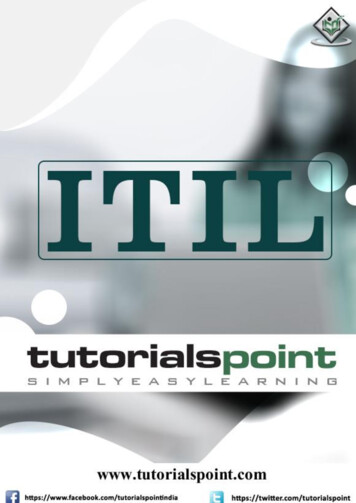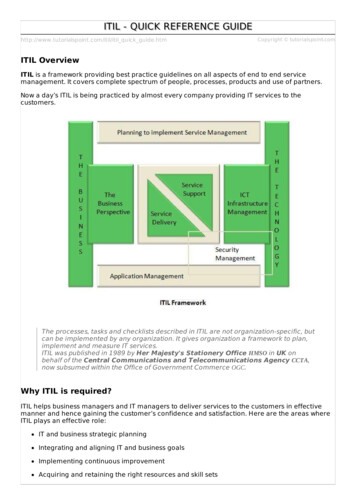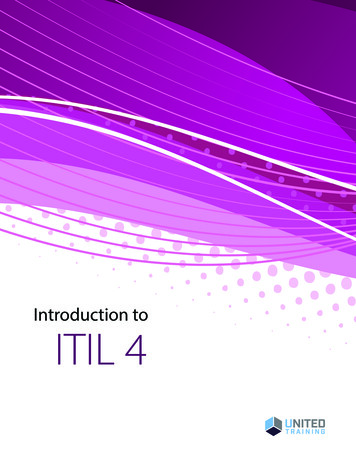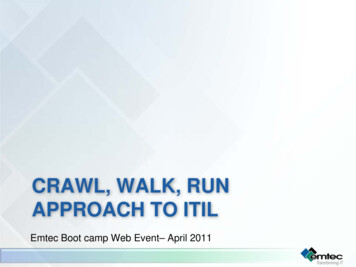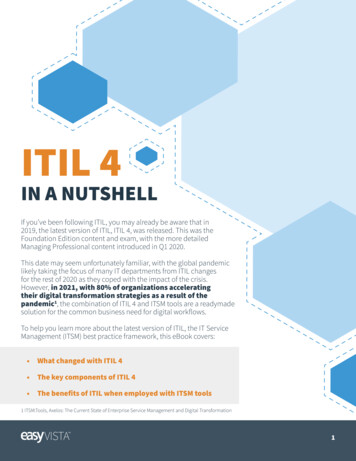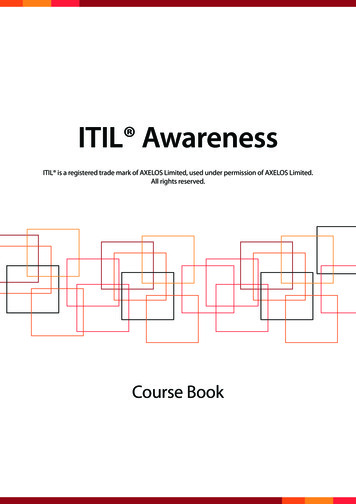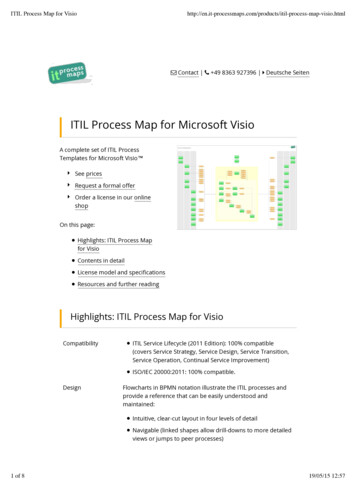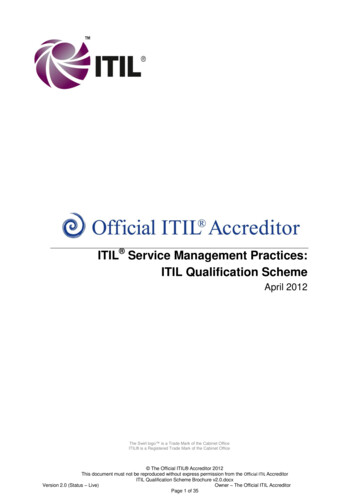
Transcription
ITIL Service Management Practices:ITIL Qualification SchemeApril 2012The Swirl logo is a Trade Mark of the Cabinet OfficeITIL is a Registered Trade Mark of the Cabinet Office The Official ITIL Accreditor 2012This document must not be reproduced without express permission from the Official ITIL AccreditorITIL Qualification Scheme Brochure v2.0.docxVersion 2.0 (Status – Live)Owner – The Official ITIL AccreditorPage 1 of 35
1.6.5.2.Scope and Purpose of Document . 4Synopsis . 4Suggested reading . 4ITIL Overview . 5What is ITIL? . 5What does „official scheme‟ mean? . 5Who is involved in the official scheme? . 6About Cabinet Office . 6About TSO. 6About The Official ITIL Accreditor (The Accreditor) . 6About Examination Institutes (EIs) . 8About Accredited Training Organizations . 8ATO Third Party Relationships . 9About ATO Affiliates . 9About Brokers (Resellers) . 9About the itSMF (IT Service Management Forum) . 9About the ITIL Qualifications Board . 9About ITIL Examinations . 10Overview . 10Syllabuses . 10Examination questions . 10Examination format . 10Other Qualifications . 10The ITIL Qualification Scheme . 11Overview . 11Design . 11Scheme Structure . 11Foundation level . 13Target Group . 13Format of the ITIL Foundation Certificate in IT Service Management Course and Exam . 13Intermediate Level . 14Target Group . 14Service Lifecycle Modules. 15Eligibility for Lifecycle Modules examinations . 15Format of the Service Lifecycle Module Courses and Examinations . 15Service Capability modules . 16Eligibility for Capability Modules examinations . 17Format of the Service Capability Module Courses and Examinations . 17Managing Across the Lifecycle . 18Format of the Managing Across the Lifecycle Module Course and Examination . 18ITIL Expert Certificate in IT Service Management . 19ITIL Master Certificate in IT Service Management . 19Curriculum . 19Pre-requisite Entry Criteria . 20ITIL Master Program: Assessment Stages . 20ITIL Qualification Scheme Credit System . 22Credit values . 22Credit and Examination Prerequisites . 24Prerequisite Exemptions . 24Selecting Modules to Achieve the ITIL Expert Certificate . 24Use of Earlier ITIL Certifications within the current ITIL scheme . 25Use of ITIL Practitioner Certificates . 25Achieving ITIL Expert Level with Practitioner Certifications . 25Enhancement of ITIL Practitioner Knowledge in an ITIL practice area . 27Use of ITIL Service Manager Certificate . 27Withdrawal of earlier ITIL Qualifications and associated bridging exams . 28Credit Administration Policy . 28Content Overlap between 1 and 19%: . 28Content Overlap between 20 and 39%: . 28 The Official ITIL Accreditor 2012This document must not be reproduced without express permission from the Official ITIL AccreditorITIL Qualification Scheme Brochure v2.0.docxVersion 2.0 (Status – Live)Owner – The Official ITIL AccreditorPage 2 of 35
tent Overlap between 40 – 79%: . 29Credit Exemptions . 30Complementary Qualification Scheme . 31Use of Complementary Qualifications and Credits in the ITIL Qualifications Scheme . 31What ITIL Examinations are Available? . 32Generic examination rules . 32Examination provision . 32Competition . 32Appeals and complaints . 33Examination Translations . 33Glossary of Terms and Acronyms . 34Contact Details . 35 The Official ITIL Accreditor 2012This document must not be reproduced without express permission from the Official ITIL AccreditorITIL Qualification Scheme Brochure v2.0.docxVersion 2.0 (Status – Live)Owner – The Official ITIL AccreditorPage 3 of 35
1. Scope and Purpose of Document1.1.SynopsisThe purpose of this document is to inform all parties interested in ITIL qualifications of the rules andguidelines of the official ITIL Qualification Scheme.The document will outline the roles and responsibilities of all official parties within the ITIL QualificationScheme as well as the overarching principles and guidelines of the scheme.1.2.Suggested readingPotential examination candidates are advised to read this entire document.Training providers, who are interested in becoming officially recognized within the Qualification Scheme,are advised to read the sections of this document relating to the qualifications and syllabus and theAccredited Training Organization Scheme Brochure.Examination Institutes (EIs) seeking approval to administer the ITIL Qualification Scheme are advised toread this entire document and the Examination Institute Scheme Brochure. The Official ITIL Accreditor 2012This document must not be reproduced without express permission from the Official ITIL AccreditorITIL Qualification Scheme Brochure v2.0.docxVersion 2.0 (Status – Live)Owner – The Official ITIL AccreditorPage 4 of 35
2. ITIL Overview2.2.1.What is ITIL?ITIL is Best Practice IT Service Management which is used by many organizations around the world. Awhole ITIL philosophy has grown up around the guidance contained within the ITIL books and thesupporting certification and qualification scheme.The ethos behind the development of ITIL is the recognition that organizations are becoming increasinglydependent on IT in order to satisfy their corporate aims and meet their business needs. This leads to anincreased requirement for reliable, high-quality IT services.ITIL provides the foundation for quality IT Service Management through documented, proven processesthat cover the entire Service Lifecycle. It is easy for organizations to learn, tailor and implement to suit theirenvironment.The widespread adoption of the ITIL guidance has encouraged organizations worldwide, both commercialand non-proprietary, to develop supporting products as part of a shared 'ITIL Philosophy'. The ITILpublications and supporting schemes are kept up to date with current best practice and changes within themarketplace through a regular review cycle to update content in collaboration with a wide range ofinternational users and stakeholders in the IT service management community.thThe latest edition of ITIL (ITIL 2011) was published on 29 July 2011.ITIL is aligned with various international quality standards including international standard ISO/IEC 20000(IT Service Management Code of Practice).2.2.What does ‘official scheme’ mean?The term „official scheme‟ refers to the rules documented in this brochure for the administration of the ITILqualification scheme recognized and endorsed by The Cabinet Office (formerly the Office of GovernmentCommerce or OGC), The ITIL Official Accreditor (The Accreditor) who are part of the APM Group tutes/ExamInstitutes.asp).This is the only ITIL qualification scheme sanctioned by Cabinet Office and is administered by TheAccreditor.There are many organizations claiming to offer ITIL qualifications and many publications claiming to be partof the official ITIL set which are not approved or recognized under the licensing scheme run by TheAccreditor or published by The Stationery Office (TSO), the official ITIL Publisher, on behalf of CabinetOffice.This document outlines the roles of the organizations within the scheme, the rules of the scheme, andcontact details and reference information for anyone wishing to check if a company is operating within thescheme.Candidates are urged to ensure that when buying ITIL training or examination services, they check that theorganization delivering the service is recognized within the scheme (see sections 3.4 and 3.5). Anyorganizations delivering services that are not accredited / approved or appropriately licensed through one ofthe scheme members may be operating illegally.Training providers are urged to ensure they secure accreditation from a recognized scheme member andare appropriately licensed before delivering services within the ITIL market place. Delivery of serviceswithout such approval may be in breach of the Intellectual Property Rights subsisting in ITIL and may resultin legal action being taken. The Official ITIL Accreditor 2012This document must not be reproduced without express permission from the Official ITIL AccreditorITIL Qualification Scheme Brochure v2.0.docxVersion 2.0 (Status – Live)Owner – The Official ITIL AccreditorPage 5 of 35
3. Who is involved in the official scheme?3.3.1.About Cabinet OfficeThe Cabinet Office is a government function which owns several best practice products. Cabinet Office arecommitted to maintaining and improving the guidance, working with organizations internationally to developand share business and practitioner guidance within a world-class best practice framework.The Cabinet Office established collaborative partnerships with two organizations to provide support for theirITIL portfolio whose contracts commenced on 01 January 2007. The Accreditor provides accreditation andlicensing services related to the Official ITIL qualification and examination scheme.The Cabinet Office manages the ITIL portfolio on behalf Her Majesty‟s Government (HMG) in the UnitedKingdom, which own the intellectual property rights in the ITIL content and data, and permit The Accreditorto use this within certain contexts within the ITIL market. Their predominant role in the official scheme isone of ownership and stewardship of the ITIL library content and qualifications.The Cabinet Office is responsible for initiating the consultation and update process to the officialpublications library, though they may outsource the management of this project to TSO.For further information please see est-managementpractice-bmp-portfolio.3.2.About TSOThe Stationery Office (TSO) is the official publisher of all core ITIL books. For further information on TSOplease visit their website at www.tso.co.uk.3.3.About The Official ITIL Accreditor (The Accreditor)The Official ITIL Accreditor (The Accreditor) is a function of The APM Group Limited which is responsiblefor the monitoring and promotion of the official scheme for ITIL EIs and training organisations.The APM Group Limited is an international professional accreditation and certification body accredited tointernational standards by UKAS (United Kingdom Accreditation Service). They run a wide variety ofschemes in many professional disciplines and have worked with Cabinet Office and their Best PracticePortfolio since 1996, successfully helping to make products such as PRINCE2 an internationallyrecognized Best Practice.The Accreditor is responsible for setting the ITIL standards and syllabuses throughout the market which anydelivering EI must adhere to, as well as creating and maintaining the ITIL qualifications scheme. TheAccreditor promotes the awareness of the ITIL official scheme through a variety of international marketingactivities, often in conjunction with Cabinet Office, TSO, the EIs and/or itSMFI and also chair the ITILQualifications Board – see section 3.7.In addition, The Accreditor is responsible for the accreditation and ongoing monitoring of any EI applying tothe official scheme to run ITIL qualifications and accreditation services, and also assist Cabinet Office inprotecting the IPR of ITIL through the issue of agreed licenses on behalf of Cabinet Office, to allow thosetraining or examination delivery organisations approved through an EI to use the associated ITIL IP. TheAccreditor also licences other organisations who wish to use ITIL IP or Trademarks in other business areas.PRINCE2 is a registered trade mark of the Cabinet Office The Official ITIL Accreditor 2012This document must not be reproduced without express permission from the Official ITIL AccreditorITIL Qualification Scheme Brochure v2.0.docxVersion 2.0 (Status – Live)Owner – The Official ITIL AccreditorPage 6 of 35
The Official ITIL Accreditor 2012This document must not be reproduced without express permission from the Official ITIL AccreditorITIL Qualification Scheme Brochure v2.0.docxVersion 2.0 (Status – Live)Owner – The Official ITIL AccreditorPage 7 of 35
3.4.About Examination Institutes (EIs)An Examination Institute (EI) is an organization accredited and licensed by The Accreditor which is therebypermitted to operate an ITIL examination scheme through a network of Accredited or Approvedorganisations or partners.The Accreditor is authorized to license EIs to administer ITIL qualification and accreditation activities.All organizations approved and duly licensed by The Accreditor as EIs will be audited by independentauditors appointed by The Accreditor in accordance with the principles of international best practicestandards and those additional rules or standards specific to the ITIL scheme – see section 5 for details.If the systems used by the applicant organizations are found to be in line with these guidelines, they will begranted permission to administer the official scheme for ITIL accreditation and examinations.Under the contracts signed with The Accreditor, EIs are allowed to undertake the following activitiesinternationally: Accredit ITIL training organizations through the standards and mechanisms audited and approvedby The Accreditor, andAdminister ITIL examinations as set down in the Syllabus and provided by the Accreditor throughthose appropriately licensed organizations they have accredited or approved using the standardsand mechanisms agreed by The Accreditor.Upon achieving licensed status, an EI will automatically earn a place on the ITIL EI Sub Group which willenable them to contribute to the EI Sub Group decision-making processes which may result in changes tothe scheme rules and requirements if ratified by the ITIL Qualifications Board.A selection of EIs may also be invited to attend the ITIL Qualification Board as determined by the CabinetOffice and stated in the ITIL Qualification Board Terms of Reference.3.5.About Accredited Training OrganizationsAccredited Training Organizations (ATOs) are organisations who have been assessed and approved by anEI, and duly licensed by The Accreditor to run accredited ITIL training courses and administer ITILexaminations.For further information please see the ITIL Service Management Practices Accredited TrainingOrganisation and Accredited Trainer scheme.An Accredited Training Organization (ATO) is an organization that has: submitted their Quality Management System (QMS), training material and trainers for assessmentby an EI,have successfully met the criteria as set out by the official ITIL scheme and the specific EIconducting the assessment, andagreed to undergo regular surveillance and monitoring, including monitoring of Cabinet Office IP reuse, to ensure they continue to meet the standards as verified during their initial accreditationassessment.As part of their assessment by an EI these accredited organizations must submit: Their QMS detailing their processes for administration of training courses and examinations,The course material for every ITIL course they utilize in training candidates for ITIL examinations,andTheir trainers for assessment by an EI.Some ATOs may choose to employ the services of other third party organisations to whom they maylicence materials, trainers and/or a QMS (Affiliates or other ATOs), or use to sell training courses on theirbehalf (Brokers). These third-party organisations are subject to specific rules relating to their operation, are The Official ITIL Accreditor 2012This document must not be reproduced without express permission from the Official ITIL AccreditorITIL Qualification Scheme Brochure v2.0.docxVersion 2.0 (Status – Live)Owner – The Official ITIL AccreditorPage 8 of 35
subject to monitoring and audit by EIs, and are required to sign a license with the Accreditor includingbrokers.3.5.1.ATO Third Party RelationshipsUnder the ITIL scheme, ATOs are permitted to enter into third party agreements with otherorganisations to aid them in the marketing, promotion and growth of their organisation.The two types of relationship which have been defined and are therefore permitted are Affiliate andBroker (or Reseller) relationships.3.5.1.1. About ATO AffiliatesAn Affiliate is a training organisation that enters into a commercial arrangement with an ATO, toenable the ATO to work in different countries or in different regions of their own country, through athird party agreement.The normal basis of this arrangement is that the ATO will make their accredited material andapproved Trainers available to run training courses in the product for which they are accredited.They may also train individuals working for the Affiliate to the appropriate standard to becomeapproved Trainers.3.5.1.2. About Brokers (Resellers)A Broker is an organisation that enters into a commercial agreement with an ATO to advertise, selland/or schedule courses on the behalf of the ATO.For full details of the conditions and rules which ATOs, Affiliates and/or Brokers must adhere to,see the ITIL Accredited Training Organisation (ATO) Scheme Brochure.3.6.About the itSMF (IT Service Management Forum)itSMF is the internationally recognized forum for IT Service Management professionals. With chapters inover 50 countries, they are able to provide local support to those individuals and organizations using andimplementing ITIL while adhering to the over-arching guidelines from the central international group.3.7.About the ITIL Qualifications BoardThe ITIL Qualification Board includes representatives of specific interested parties within the communityfrom around the world. Members of the Board will be invited by the Cabinet Office and will include, though are not limited to representatives from Cabinet Office, The Official ITIL Accreditor, TSO, the ITILExamination Panel, EI Sub Group, user groups and the ATO Sub Group.The Qualifications Board exists to enable Cabinet Office, supported by The Accreditor, to manage the ITILqualification scheme in the interest of all stakeholders, with the major focus being the individuals achievingthe ITIL specific qualification status. Within that context, members of the board are invited to considermatters fairly, objectively and unbiased from commercial influences. The board does not have a formalvoting system but in the event that agreement on a subject cannot be reached, Cabinet Office will make thefinal decision. The Official ITIL Accreditor 2012This document must not be reproduced without express permission from the Official ITIL AccreditorITIL Qualification Scheme Brochure v2.0.docxVersion 2.0 (Status – Live)Owner – The Official ITIL AccreditorPage 9 of 35
4. About ITIL Examinations4.4.1.OverviewThe ITIL core publications were last published on 29 July 2011. This document outlines the qualificationsthat support this latest release of the ITIL Best Practice Guidance4.1.1.SyllabusesThe Official ITIL Accreditor (the Accreditor) develops and maintains all the ITIL syllabuses for use by allEIs. EIs are not permitted to amend or develop ITIL syllabuses or qualifications. The Accreditor has aninternational group of ITIL experts who produce, update and maintain the syllabuses for all ITILqualifications.These syllabuses are subject to sign-off by the ITIL Qualification Board and are then released for useby any EI that is approved to run the official ITIL qualifications.4.1.2.Examination questionsThe Accreditor uses the same group of international ITIL experts that develop the syllabuses to lead onthe creation of ITIL examination questions. The Accreditor maintains and updates these questions on afrequent basis in the light of the feedback received from ATOs and candidates.The Accreditor is responsible for the official examination questions and license them to EIs approved torun the official scheme.4.1.3.Examination formatAll ITIL examinations reflect the lifecycle based structure within the ITIL Best Practice guidance, andare therefore modular in nature.All examinations are multiple choice and have been designed to test at a variety of levels of difficulty inlearning process using Bloom‟s Taxonomy principles adapted to the specific ITIL principles. The level ofdifficulty depends on the level of scheme or qualification supported.4.1.4.Other QualificationsThe ITIL Master Qualification is the highest level of qualification achievement possible within the officialITIL scheme. This qualification does not have a supporting examination, but tests via assessment ofwritten submissions and oral interview. The Official ITIL Accreditor 2012This document must not be reproduced without express permission from the Official ITIL AccreditorITIL Qualification Scheme Brochure v2.0.docxVersion 2.0 (Status – Live)Owner – The Official ITIL AccreditorPage 10 of 35
5. The ITIL Qualification Scheme5.5.1.OverviewThe purpose of the ITIL Qualification Scheme is to ensure that relevant qualifications are available tosupport the formalized learning requirements of individuals and organizations related to the ITIL ServiceManagement Practices.5.1.1.DesignThe design principles of the scheme specify that the Qualification Scheme must: offer qualifications that are of value to the career objectives of the studentoffer flexibility in how they can be deliveredprovide knowledge that meets the stated learning objectives and competency outcomesalign to Bloom‟s Taxonomy levels of abstraction for setting examination questions against thesyllabuscontribute to the maturity of ITSM professionalismbe responsive to evolving market demandprovide a transitional upgrading strategy and supporting qualifications for those wishing toenhance earlier ITIL qualifications to the current model, and those mid-stream wishing tocomplete qualifications under the current schemeThe ITIL Qualification Scheme is aligned to the construct of the ITIL Service Management Practicescore guidance. The current core guidance has expanded upon earlier ITIL guidance by includingbroader ITSM practices. The result is an increase in scope, breadth and depth of the syllabuses.The basic design incorporates a modular structure for qualifications to provide flexibility in the customerselection and the use of a credit system to achieve the Expert Certificate in ITSM and also to supportinnovative delivery mechanisms by the ATO community.5.1.2.Scheme StructureThe Qualification Scheme, as approved by the ITIL Qualification Board, is based on content of the coreITIL Service Management Practices publications, namely service strategy, service design, servicetransition, service operation and continual service improvement.The subject and content areas as included in the ITIL core publications have been grouped into avariety of combinations which cover the ITIL Service Management practice Lifecycle and Capabilityelements, and are organized into three levels. The Official ITIL Accreditor 2012This document must not be reproduced without express permission from the Official ITIL AccreditorITIL Qualification Scheme Brochure v2.0.docxVersion 2.0 (Status – Live)Owner – The Official ITIL AccreditorPage 11 of 35
Figure 1 - ITIL Qualification Scheme Structure The Official ITIL Accreditor 2012This document must not be reproduced without express permission from the Official ITIL AccreditorITIL Qualification Schem
ITIL Qualification Scheme Brochure v2.0.docx Version 2.0 (Status - Live) Owner - The Official ITIL Accreditor Page 1 of 35 ITIL Service Management Practices: ITIL Qualification Scheme April 2012 The Swirl logo is a Trade Mark of the Cabinet Office ITIL is a Registered Trade Mark of the Cabinet Office


